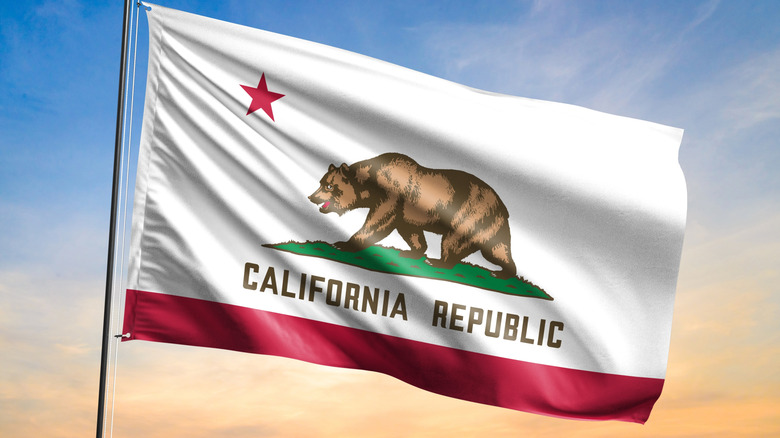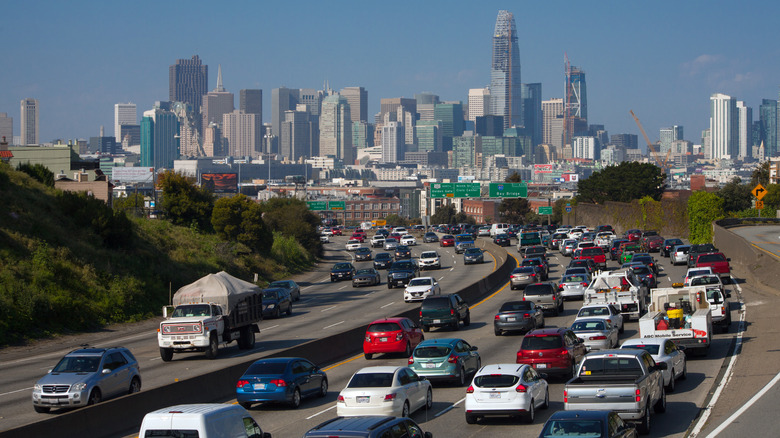Why Car Insurance In California Isn't Cheap (And Why It's So Hard For Drivers To Get It)
Driving can be fun and convenient, but its downsides can't be ignored. There's inherent danger to getting behind the wheel and loads of paperwork when buying a car, and insurance is a whole other can of worms. You need to determine what kind of coverage you need, what features warrant higher or lower rates, and which company to go with. Auto insurance companies can use your data in the worst ways, so there's that to be mindful of, too. And on top of it all is the cost, which can get quite high — especially if you're a California resident. The state's high rates are due to a multitude of factors out of drivers' control.
Lots of things affect insurance rates — the car's color not being one of them, for those curious. The vehicle, level of coverage, and driving history are some of the biggest, and inflation hasn't helped in recent times, either. But in California, other state-specific elements contribute to it being costly. Aspects of California life lead insurance companies to offer higher rates than they would for drivers in other states. Its high population density is seen as a bigger risk, the state contains more uninsured drivers than most, and automotive repairs and life in general cost considerably more in California than other states.
But cost is just one of the major headaches involving California auto insurance. If you apply for it there, you could be waiting awhile, if you're fortunate enough to not be rejected outright.
Is auto insurance in California made purposely difficult to get?
Some point to regulations like Proposition 103 as partially to blame for automotive insurance being difficult to obtain in California. This law prevents insurance companies from raising rates arbitrarily, forcing them to justify any increases. To try getting their higher rates approved, insurance companies have reportedly caused slowdowns in the acceptance process via questionnaires, waiting periods, and other means. Drivers are left without insurance while insurance companies play hardball to get their rate increases approved, so they can end these seemingly intentional near-standstills.
The California government has taken steps to end such practices, but folks are still ending up caught in the crossfire of this tug-of-war. As if waiting longer than usual for coverage to kick in isn't bad enough, some companies are limiting the number of customers they take on. Barbara Caudana of Conrey Insurance Brokers and Risk Management talked about that to the Los Angeles Times, adding, "We're working really hard to not ever say to a person, 'Jeez, I'm sorry there's nothing we can do.'" This is particularly a problem for new drivers or those seeking a better rate with a different company.
Between high prices and struggles to get insured in the first place, it's not a fun time to be a California driver. All you can do is try your best to get insured and find the best rate possible.
What can California drivers do about all this?
To combat all of the negatives that come from getting automotive insurance in California, there are a few things drivers can do. Doing some research is always a great first step. Compare rates across multiple companies — the best and worst of the major car insurance companies – and note what's covered for the price. This way, you can narrow down which company is best for you, your vehicle, and your wallet. Ideally, whichever you choose won't ultimately burden you with a tedious, unnecessary wait period, or deny you altogether.
Also worth looking into, especially if price is your biggest concern, is the California Low Cost Automobile Program. Established in 1999, this initiative is designed to get low-income drivers insured for a rate that won't leave them flat broke. As far as the qualifications go, you need to be considered a "Good Driver" or be new to the road, be at least 16 years old, have a car worth less than $25,000, have a valid California driver's license, and meet income requirements. If approved, you could be looking at yearly premiums between approximately $200 and just under $1,000 per year.
The auto insurance world isn't a joy to navigate, but California drivers definitely have it worse than most. Time will tell if it gets cheaper and easier to obtain for them, or if it'll continue to be an overall pain.


